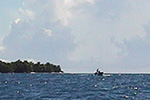
A female leatherback surveys the ocean at Playa Grande, Costa Rica. While her hatchlings will be affected by rising beach temperatures, she faces threats at sea. Photo by: The Leatherback Trust.
A drier, hotter climate in Central America could wipe out the population of leatherback sea turtles from the eastern Pacific Ocean by the year 2100, according to a grim projection published on July 1 in Nature Climate Change. Already critically endangered from fisheries by-catch and historic egg poaching, leatherbacks can hardly accommodate another human-related threat. Yet scientists still hold out hope for interventions that could save the turtles.
Leatherbacks (Dermochelys coriacea)—the largest turtles on Earth—spend most of their lives at sea, only hauling their rubbery bodies onto the beach every three to four years to lay eggs in deep holes they dig in the sand. This is no small feat, as the turtles can weigh up to a ton. The number of hatchlings that emerge from each clutch depends greatly upon the temperature and moisture of the sand. Fewer baby turtles survive in hot, dry conditions, whereas cooler, wetter conditions provide more fertile ground. The most recent projections from the Intergovernmental Panel on Climate Change (IPCC) concur that Central America will become hotter and drier during the 21st century, a scenario that does not bode well for the region’s leatherbacks.
Scientists from Princeton University, Drexel University, Indiana-Purdue University, and the National Oceanic and Atmospheric Administration (NOAA) assessed how these trends might affect a well-studied population of leatherbacks at Playa Grande beach in northwestern Costa Rica. One of four nesting sites in the eastern Pacific, the beach is protected within the boundaries of Las Baulas National Park. The team merged seven leading climate models with a leatherback population model based on data gathered at the nesting beach for more than 20 years.
 Cooling nests to counter climate change. Researchers at Playa Grande hope to counter the effects of climate change by watering and shading leatherback nests. Photo by: The Leatherback Trust. |
They found that by the year 2100, rising beach temperatures could cut the leatherback population at Playa Grande by three-quarters. This is a daunting projection, as leatherback numbers there already have dropped from nearly 1,500 nesting females in 1991 to about 40 in 2011 due to egg poaching and fisheries by-catch. Egg poaching was put to a halt in 1990 with the founding of Las Baulas National Park, but fisheries remain an imminent threat.
“My main concern is not climate change right now; it’s what’s happening in the ocean,” said first author and NOAA fisheries biologist Vincent Saba in an interview with mongabay.com. “Lots of countries have laws, but the problem comes with enforcing them,” he said, noting that enforcement costs are too high for many poor countries. Grassroots organizations like Pro Delphinus in Peru are working closely with fishermen to promote changes in fisheries practices that will save turtles.
To address the threat posed by climate change, coauthor Pilar Santidrian Tomillo, a field ecologist from Drexel University, is experimenting with shading and watering leatherback nests at Playa Grande to cool them down. “We’re doing an experiment to see how the effects of shading and watering would change temperature and humidity in the sand,” explained Tomillo in an interview from Costa Rica. If the work succeeds, it could help the turtle population cope with rising beach temperatures.
George Meehl, a climate scientist at the U.S. National Center for Atmospheric Research who was not involved in the study, told mongabay.com that the research is a good example of climate data being put into action. “You’re taking climate change information and trying to actually do something with it,” Meehl said. “This is a sequence we like to see.”

Leathery hatchlings emerge from a sandy nest. Rising beach temperatures threaten hatchling survival in the sand. Photo by: The Leatherback Trust.
Jessica Shugart is a graduate student in the Science Communication Program at the University of California, Santa Cruz.
CITATION: Saba, V.S., Stock, C.A., Spotila, J.R., Paladino, F.P., Santidrián-Tomillo, P. 2012. Projected response of an endangered marine turtle population to climate change. Nature Climate Change, 2, 814-820. DOI: 10.1038/nclimate1582
Related articles
Jaguar v. sea turtle: when land and marine conservation icons collide

(05/16/2012) At first, an encounter between a jaguar (Panthera onca) and a green sea turtle (Chelonia mydas) seems improbable, even ridiculous, but the two species do come into fatal contact when a female turtle, every two to four years, crawls up a jungle beach to lay her eggs. A hungry jaguar will attack the nesting turtle, killing it with a bite to the neck, and dragging the massive animal—sometime all the way into the jungle—to eat the muscles around the neck and flippers. Despite the surprising nature of such encounters, this behavior, and its impact on populations, has been little studied. Now, a new study in Costa Rica’s Tortuguero National Park has documented five years of jaguar attacks on marine turtles—and finds these encounters are not only more common than expected, but on the rise.
Leatherback sea turtles granted massive protected area along U.S. west coast

(01/23/2012) The U.S. federal government has designated 108,556 square kilometers (41,914 square miles) as critical habitat for the leatherback sea turtle (Dermochelys coriacea), the largest of the world’s marine turtles and one of the most endangered. The protected area, around the size of Guatemala, spans coastal sea waters from California to Washington state, but does not protect the migration routes environmentalists hoped for.
Featured video: tuna industry bycatch includes sea turtles, dolphins, whales
(01/16/2012) A Greenpeace video, using footage from a whistleblower, shows disturbing images of the tuna industry operating in the unregulated waters of the Pacific Ocean. Using fish aggregation devices (FADs) and purse seine nets, the industry is not only able to catch entire schools of tuna, including juvenile, but also whatever else is in the area of the net.
Leatherback sea turtles tracked for first time in South Atlantic
(01/07/2011) Leatherback sea turtles undertake one of the longest journeys of any animal as they traverse the oceans in search of food, navigating hazards such as plastic pollution and fishing operations. A new study published in the Royal Society Journal Proceedings B has for the first time mapped their odyssey through the South Atlantic.
‘Environmental and social aggression’: oil exploration threatens award-winning marine protected area

(12/01/2010) The Seaflower Marine Protected Area (MPA), which recently won top honors at the Convention on Biological Diversity (CBD) in Japan, is now under threat by planned oil exploration in the region, according to the Providence Foundation which is devoted to protecting the area. Proposed blocs for exploration by the Colombian government lie in the North Cays adjacent to the park, and perhaps even inside MPA boundaries. Spreading over 65,000 square kilometers (6.5 million hectares), Seaflower MPA lies within the Colombian Caribbean department known as the Archipelago of San Andres, Old Providence and Santa Catalina. This richly diverse Archipelago is home to a known 57 coral species, over 400 fish, and some 150 birds, as well as the ethnic and cultural minority: the Raizal people. The prospect of massive infrastructure or, even worse, oil spills in the area could devastate the park and locals’ livelihoods.